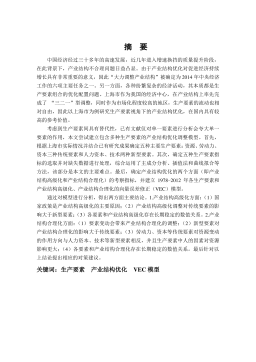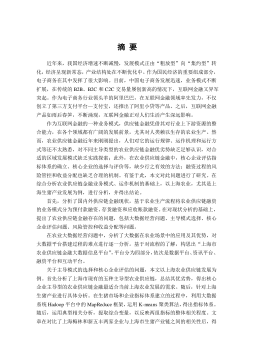公共财政框架下我国义务教育经费投入的现状、问题及对策研究
摘要义务教育及其经费投入是我国社会目前关注的一个焦点问题,同时也是政府一直试图解决好的突出问题。《义务教育法》的颁布以及国家相继出台的相关政策,使得我国义务教育事业无论是在“量”、还是在“质”上都取得了显著成绩。主要表现在三个方面:一是义务教育已经普及;二是义务教育正在全面免除学杂费;三是义务教育软、硬件得到了明显改善。然而,义务教育在快速发展过程中也遇到了一些问题或者说是难题。通过去各地相关部门走访调研以及对相关文献资料的归纳和分析,认为目前义务教育公共财政投入主要存在三大问题:一是投入依然不足;二是投入存在较大的地区间不均衡;三是外来务工人员子女就地上公办学校难。基于上述问题,论文尝试从财...
相关推荐
-
我国基层财政困难的制度成因分析与对策研究VIP免费

 2024-09-20 46
2024-09-20 46 -
我国煤电产业链纵向交易合约机制研究VIP免费

 2024-09-20 43
2024-09-20 43 -
生产要素视角下的上海市产业结构优化研究VIP免费

 2025-01-09 8
2025-01-09 8 -
我国银行业结构与经济结构关系研究VIP免费

 2025-01-09 17
2025-01-09 17 -
大数据视角下农业供应链金融研究VIP免费

 2025-01-09 14
2025-01-09 14 -
跨国大型综合超市的规划研究VIP免费

 2025-01-09 9
2025-01-09 9 -
跨境电商农产品质量安全问题研究VIP免费

 2025-01-09 9
2025-01-09 9 -
世界市场的虚拟化与我国国际电子商务发展方向研究VIP免费

 2025-01-09 43
2025-01-09 43 -
中国政府对电力行业的价格规制问题研究VIP免费

 2025-01-09 18
2025-01-09 18 -
中小企业信息化系统集成技术研究VIP免费

 2025-01-09 30
2025-01-09 30
相关内容
-

跨国大型综合超市的规划研究
分类:高等教育资料
时间:2025-01-09
标签:无
格式:PDF
价格:15 积分
-

跨境电商农产品质量安全问题研究
分类:高等教育资料
时间:2025-01-09
标签:无
格式:PDF
价格:15 积分
-

世界市场的虚拟化与我国国际电子商务发展方向研究
分类:高等教育资料
时间:2025-01-09
标签:无
格式:PDF
价格:15 积分
-

中国政府对电力行业的价格规制问题研究
分类:高等教育资料
时间:2025-01-09
标签:无
格式:PDF
价格:15 积分
-

中小企业信息化系统集成技术研究
分类:高等教育资料
时间:2025-01-09
标签:无
格式:PDF
价格:15 积分





